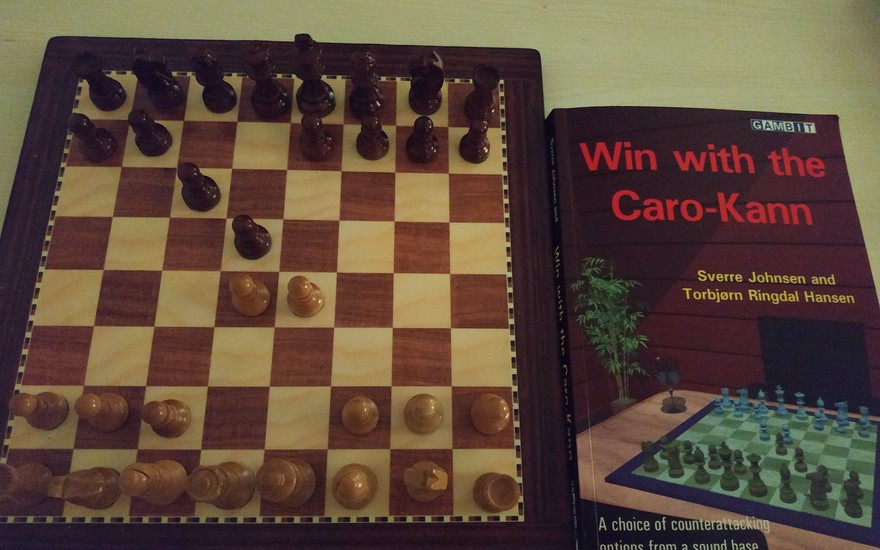
Review of Win with the Caro-Kann by Johnsen and Hansen
This is a review by FM James Vigus of Sverre Johnsen and Torbjorn Ringdal Hansen's 'Win with the Caro-Kann'Win with the Caro-Kann
by Sverre Johnsen and Torbjorn Ringdal Hansen
Gambit, 240 pages, 2021
CORRECTION: The original version of this review incorrectly stated that the book lacked analysis of the line 1 e4 c6 2 d4 d5 3 Nc3 dxe4 4 Nxe4 Bf5 5 Qf3 (p. 67). I apologise to the authors and publisher for this error.
----------
Recently I've started to learn the Caro-Kann for Black. I've mainly used this book together with GM Erwin l'Ami's Chessable course (2020). There is quite a bit of overlap between the lines covered in these two works. L'Ami's course is excellent - but this review focuses on the book by Johnsen and Hansen.
The authors
Both authors are from Norway. Sverre Johnsen is an untitled player, but has successfully co-authored previous opening books, notably on the London System and the Stonewall Dutch. GM Torbjorn Ringdal Hansen is a full-time chess trainer and plays the Caro-Kann himself. The two authors seem to have collaborated well. Each took primary responsibility for different sections, but clearly checked each other's work and worked together to ensure a coherent set of recommendations.
The layout
The explanatory prose is both concise and clear throughout. The large-format pages are nicely laid-out, yet quite densely packed. Inevitably given the state of modern opening theory, there is a great deal of material in this book.
The authors help the reader navigate the variations with a step-by-step method and sometimes by indicating priorities or giving other pointers (e.g. 'The current lesson isn't very theoretical, so there isn't much hard word demanded here'). Each chapter consists of 'lessons', each beginning with a 'model game' to introduce the main themes and plans. There then follows a section of 'theory magnifiers' labelled (for chapter 1) 1A, 1B, and so on.
The drawback I found to this format is that I sometimes had to flick back and forth to locate a particular line. This can get a little tricky when transpositions are frequent. However, the index is very user-friendly and tends to resolve this problem. On the whole, the 'lesson' format is helpful for orienting readers who are new to the opening (as I essentially was).
The opening
The Caro-Kann is the height of fashion - with good reason. As a reply to 1 e4 it provides a less theory-heavy middle way between 1...e5 (relatively solid) and 1...c5 (relatively sharp). It is solid enough to use against a stronger opponent, while there are no obvious forced draws so it's good for keeping the tension against weaker opposition, too. Win with the Caro-Kann shows impressively how this balance works in practice.
Other material on the Caro-Kann
Publications on the Caro-Kann have been pouring out lately. The 'main sources' cited in the bibliography are:
- Rambaldi, The Caro-Kann Revisited (2020)
- Bologan, Bologan's Caro-Kann (2018)
- Kornev, A Practical Black Repertoire with d5, c6. Volume 2 (2017)
- Karpov & Podgaets, The Caro-Kann Defense: Classical Variation (2016)
- Houska, Opening Repertoire: The Caro-Kann (2015)
There is little overlap with Fernandez's The Modernized Caro-Kann (2018), which is presumably why it is not listed.
Schandorff's Grandmaster Repertoire is cited, but the 2010 first edition rather than the new 2021 version, which appeared around the same time as the book under review. I assume l'Ami's Chessable course also appeared too late to be considered.
I wonder why the authors didn't consult two ChessBase DVDs by GMs that share their main-line recommendation:
- Vidit, The Fashionable Caro-Kann (2 DVDs, 2017)
- Baldauf, Caro-Kann - Berliner Geheimvariante (2 DVDS, 2019)
As discussed below, I felt they could also have usefully referred to some of the older literature on the opening. Nowadays it's totally impractical for authors to check all significant sources. But the net might have been cast a little wider.
The repertoire
Johnsen and Hansen provide a complete repertoire for Black with 1 e4 c6.
Against the Advance Variation, 2 d4 d5 3 e5, they choose the trendy 3...c5. This is what Hansen plays and it keeps the quantity of theory down considerably. A lovely touch is the 'experimental' alternative 3...Qc7, which they don't pretend is the best move, but it should set opponents thinking on move 4. Personally I prefer the traditional 3...Bf5, but the 'Arkell-Khenkin' 3...c5 line seems to hold up well - and it gives Black chances for the initiative.
I also really like the recommendation against the Panov Attack, 2 d4 d5 3 cxd5 exd5 4 c4, which is 4...Nf6 5 Nc3 (or 5 Nf3) g6. Again, this cuts down on memorization compared with the rather daunting main lines after 5...Nc6. Here Johnsen has turned for inspiration to David Smerdon's book Smerdon's Scandinavian (2015), to which transpositions sometimes occur.
Relatively minor options like the Two Knights (2 Nc3 d5 3 Nf3, met with 3...Bg4) and the King's Indian Attack (2 d3 intending a kingside fianchetto) are handled in a way that inspires confidence.
Against the main line, 2 d4 d5 3 Nc3 (or 3 Nd2) dxe4 4 Nxe4 they helpfully provide two responses of equal weight. It's definitely useful as a Caro-Kann player to be able to vary one's choice here.
Thus, we get a choice of:
- 4...Nf6 5 Nxf6+ exf6
- 4...Bf5
General evaluation
My impression from working with this book for a while is that the main lines are analysed very conscientiously. This is of course the most important aspect. However, an occasional corner is cut with less critical lines (see below).
The 'Capablanca' Variation (4...Bf5)
This remains very solid for Black. I'll focus on an interesting sideline, 5 Qf3 (p. 67):
The 'Korchnoi Variation' (4...Nf6 5 Nxf6+ exf6)
I'll focus on this highly fashionable line for the remainder of the review.
First, a side-note on the nomenclature: I imagine this line is often named after Korchnoi because he is the only player to have used it in a world championship match:
Karpov-Korchnoi
But he otherwise didn't play it much (or at all?). This was in fact one of theearliest methods of playing this opening (see Lasker-Caro, 1886), so perhaps it deserves to be called the 'original variation'.
Let's rewind a moment, though. What if White doesn't take on f6?
He could try 5 Bd3... Johnsen & Hansen have nothing directly to say about that; though as we'll see, they do give something useful on it by accident, via the move-order 4...Bf5 5 Bd3. It is not entirely trivial to deal with, and a look at some old sources proves helpful.
Introduction to 5 Bd3:
A crushing win with White by Alekhine:
Finally, here is my recommendation for Black against this gambit:
Or how about 5 Ng3? Another non-critical move, but a reasonable one, as Black has to think about how to develop the queen's bishop. This time Johnsen & Hansen have it covered. However, this section rather typically omits some candidate moves for White:
It's also interesting to note that their tactical justification for the thrust 5...h5 was known over a hundred years ago.
Usually White captures: 5 Nxf6+ exf6. This recapture, long considered super-solid, has now superseded 5...gxf6 and become an interesting try for Black to play for a win. This is due to a new discovery in which Hansen has been in the vanguard, in the main line with 6 c3.
But before we get to that, let's look at the old main move, 6 Bc4. The authors give the impression that this is not particularly challenging for Black. However, there are two problems with their analysis of their preferred continuation, 6...Bd6:
(i) 7 Qe2+ Be7 8 Qh5 'move-orders' Black out of their repertoire. Fortunately this is not a major theoretical issue.
(ii) Instead of 8 Qh5, 8 Nf3 0-0 9 0-0 Re8, they omit the important move 10 Qd3.
Ok, more work for the reader, then! Here we go:
https://lichess.org/study/NoOFi4yz/98pywyF0
If you're new to all this you may be wondering what the attraction of the 'original' 5...exf6 is. Black has a fantastic idea after
6 c3 Bd6 7 Bd3 0-0 8 Qc2 Re8+ 9 Ne2 which used to lead to a kingside attack for White.
The new(ish) move is 9...h5!
What's not to like? Your king stays safe behind a wall of pawns, while you gain space with impunity - with the move that everyone loves to play in the age of Alpha Zero.
I found Johnsen & Hansen's treatment of this line very convincing and instructive. It surely helps that Hansen has been one of its most notable practitioners (so much so that Johnsen insists on naming it after his co-author).
Black often has most fun when White castles queenside, and a plan like ...Nd7-d8, ...Be6, ...Bc7, ...b5 and ...Qd5 swings into action.
I've taken a critical look at this, too, without finding any serious problems.
However, one of the key lines with kingside castling by White deserves some more probing:
In conclusion, this is a practical, reliable and in places inspiring guide to an opening that is fashionable without being totally overwhelming to learn. I've pointed out some relatively minor glitches - but none of them constitute significant problems for the repertoire. Whether you prefer this book, or l'Ami's course, or Schandorff's updated repertoire book, or one of the other works listed above, is one of those intricate consumer choices with which chessplayers are increasingly confronted. Win with the Caro-Kann is in any case a good purchase.
Finally, here is John Nunn's video about the book: https://www.youtube.com/watch?v=6K0zg1b5ETU
More blog posts by Minckwitz

Review: The Perfect Pirc-Modern by Viktor Moskalenko
This is a review by FM James Vigus of Moskalenko's The Perfect Pirc-Modern
Review: Some instructional and training works
Review by FM James Vigus of recent training/calculation books
Review: Basman's Folly (1 g4) by Lakdawala and Hansen
Review by FM James Vigus of Lakdawala & Hansen's book on the Grob